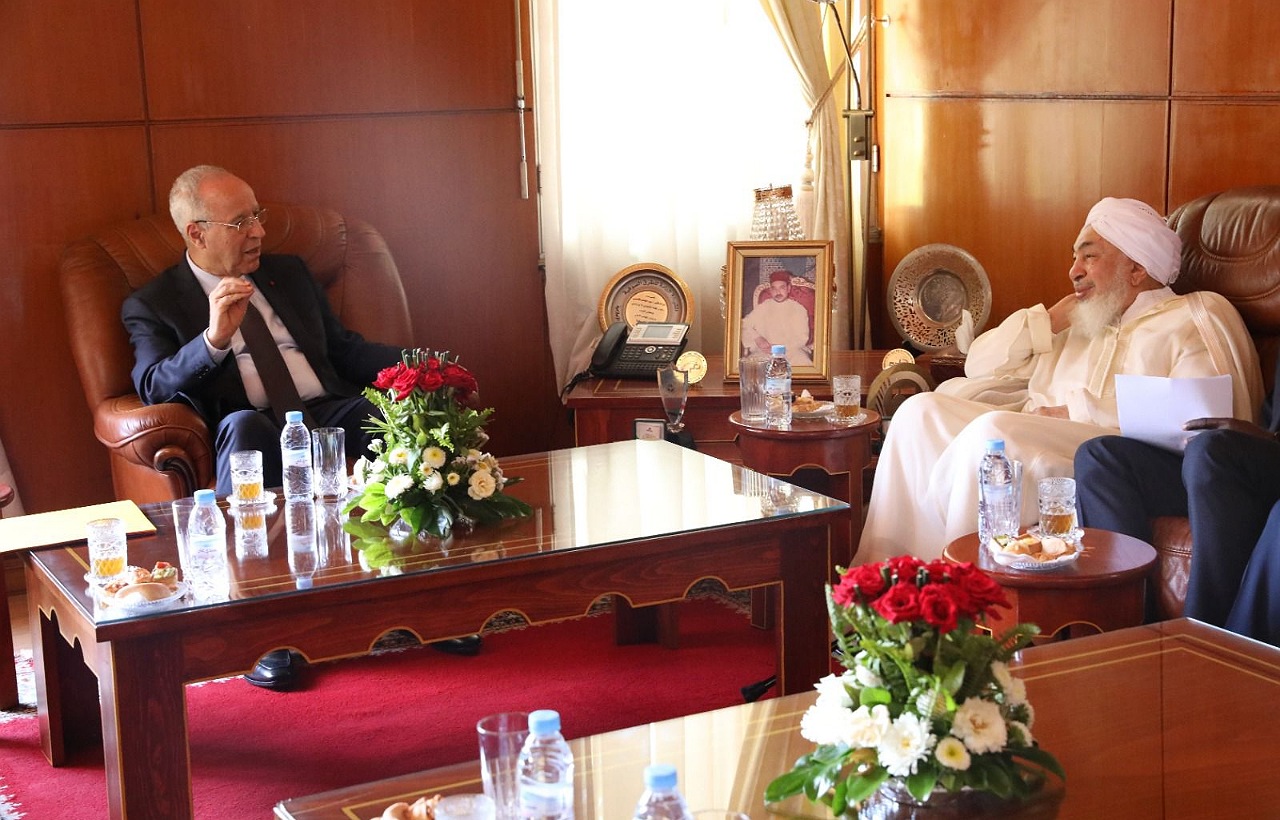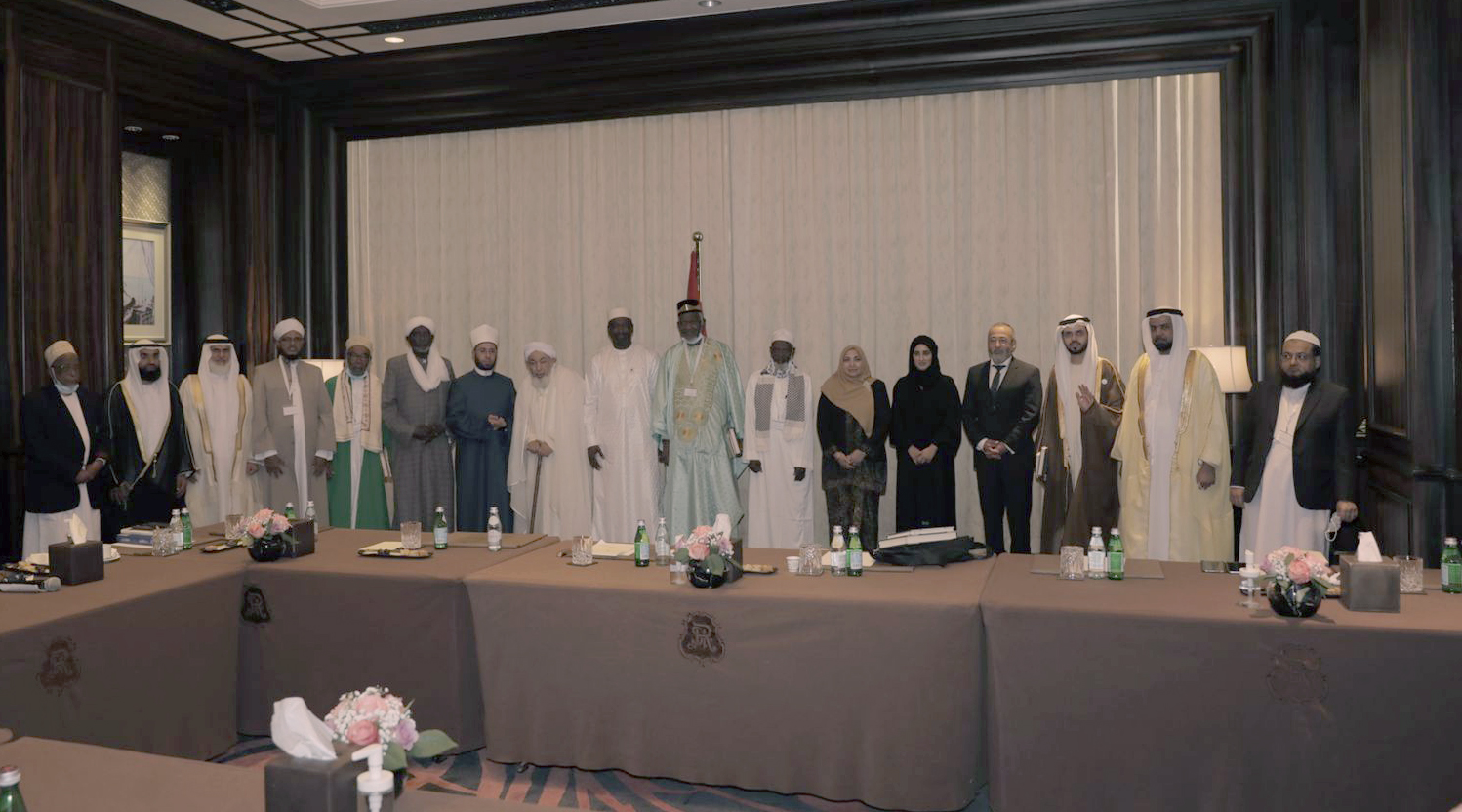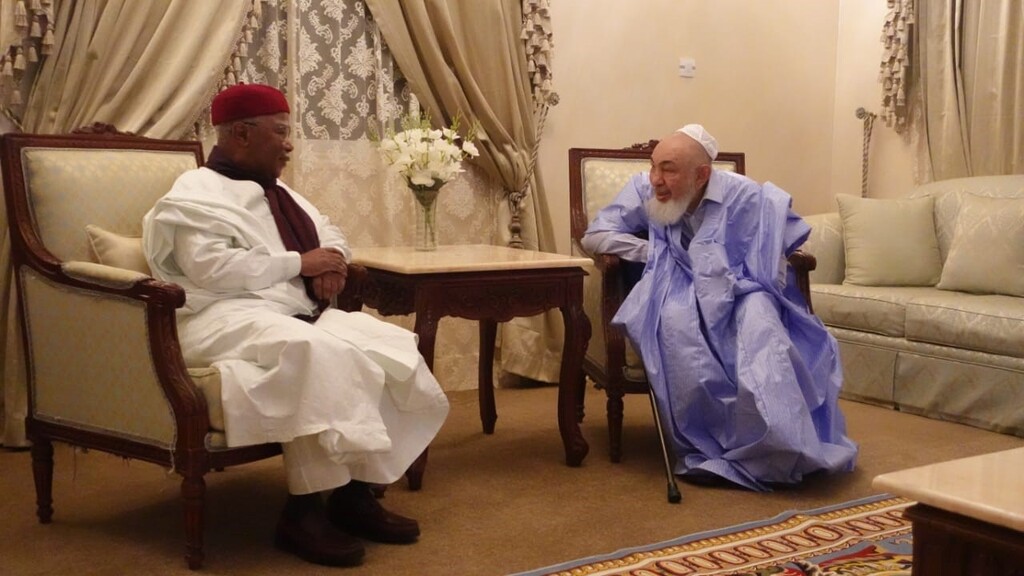On Judging ‘Scientific Miracles’
By Shaykh Abdullah bin Bayyah
Translated by Yusuf Lenfest
In the name of God, the Merciful, the Compassionate
All praise is due to God
May peace and blessings be sent upon the Prophet and his companions
“Scientific miracles” is a modern term and refers to discoveries of science in the contemporary age in relation to newly uncovered facts or realities which were previously undiscoverable, yet which also remain in conformity with reports contained in the Qur’an or the prophetic Sunna.
Herein we will discuss the connection between the Qur’an and the natural laws and signs in the universe or in the perceptible human senses and mind.
Religion versus Science
Believing in this noble religion means that we also believe that the Creator sealed the heavenly religions with Islam, and that He sent Muhammad as the final Prophet for all mankind, peace and blessings be upon him.
In the centuries since God revealed the Qur’an to his Prophet, Islam has refuted many falsehoods yet it has also faced many challenges.
One challenge encountered by this religion was the initial threat of annihilation and expulsion of its followers. Allah says of this challenge of provocation upon the earth in the Qur’an, “And they surely wished to scare you from the land in order to expel you therefrom; but if so they would not have remained there after you” (Al-‘Isra’ 76). This verse was revealed in Makkah during the Prophet’s time there in the early part of his mission, and indeed, no one from amongst those who taunted him or expelled him from his birthplace remained except that, 15 months later, they were defeated in the Battle of Badr. It is said in the book ‘Enlightenment and Liberation’: “That verse is in reference to the Prophet, peace be upon him, that he would be barred from Makkah and that his perpetrators would be expelled soon thereafter.”
The early pagan Arabs and others who were hostile to Islam dreamt of eradicating the religion altogether; however, Allah — glorious and transcendent is He — destined a supply of strength by His help and power until, in less than a century, the Muslims achieved a geographic expansion from China to the Pyrenees mountains, thus ensuring the survival of this religion forever.
A second challenge comes from both revealed religions and non-revealed religions, with competing claims of truth. But with its absolute monotheism, just legislation, and message of equality, Islam engages with other religions and faiths in the fairest manner, using gentle persuasion, clear evidence and proofs and honest, unbiased arguments. The Qur’an’s message of the oneness and unity of God, coupled with the light of Prophethood and inimitability of Revelation has provided the ground for all subsequent arguments or defence of truth, whether historical or theological.
The third challenge is philosophy. Western philosophy in particular, such as Aristotelianism and ancient Greek philosophy, had already been incorporated into Christianity, and non-indigenous concepts and atheistic presuppositions were sometimes to be reconciled to the faith. Equipped with sound logic and supported by irrefutable revelation, however, Muslim scholars exposed the falsity of such fallacies by both debunking and denouncing its methodologies. Scholars such as Abu Hamid al-Ghazali, Ibn Taymiyyah and Ibn Rushd—despite philosophical differences amongst themselves—stood as a common bulwark against the fatal errors of philosophy yet also sought to clarify—by the light of revelation—the positive elements which could be integrated, all in a uniquely constructive give-and-take. As a result, the Enlightenment philosophers in the West benefited much from Islamic philosophy and, as the Andalusian scholar Abu Bakr Ibn al-‘Arabi said, “The true religion emerged over and above its opponents by virtue of compelling argument, not by the sword.”
In this past century, traditional religions—and especially Islam—have faced continued challenges. Today, the modern age of technology and materialism has become a new challenge, whose negative aspects are influencing the younger generations by sowing doubt in the mind, often unfortunately to the detriment of empathy and values. So how can we regain touch and reacquaint our lives with a virtuous ethics and safeguard our human rights? For with rampant weapons and pernicious technologies at hand, if man is stripped of his humanity, he will too quickly descend into self-destruction and pose a threat to himself and others.
God’s words on predestination (mirsad) and verses like it served as responses to challenges in various facets and areas in sharia, legislation, education, spirituality, morality, etc. Now, however, in somewhat of a reversal, modern science has come out with additional evidences from the physical world which corroborates the veracity of revelation—that is, on certain things originally pronounced by God in the Qur’an, Who spoke everything with the truth of revelation and testimony, but now articulated by science: “The magic has turned against the magician,” as the Arabic proverb goes. Those who wish to use science as a proof against religion will therefore not find substance to refute Islam, since many unprecedented scientific demonstrations have been found within the texts of both the Qur’an and Sunna.
Many figures of modern science have acknowledged that Islamic religious texts are not like other religious texts in which people have distorted and altered meanings in such a way that they have been made incompatible with science. Compared to numerous disagreements in other scriptures, only the noble Qur’an, as argued by the French physician Maurice Bucaille in his book ‘L’homme d’ou vient-il?: Les reponses de la science et des Ecritures saintes’ contains no contradicting statements of established scientific fact. Indeed, we believe that the Qur’an is the only sacred text divinely protected and irrefutable which stands as evidence of its divine origin and the truthfulness of the final messenger, Prophet Muhammad—peace and blessings of God be upon him.
Today, science is a testament to the miraculous and a sign of the sincerity of the chosen Prophet. Before discussing “scientific miracle” in more detail, however, we should first define some relevant terms related to the subject: miracle, proof, sign and verse.
Miracle: is an extraordinary event that appears to defy the laws of nature or science and so is considered to be “inexplicable,” or attributed to a supernatural origin, or an act of God. It is what some defined as “something wondrous coupled with the challenge of breaking conventional norms in a certain context, free of being reproduced.” The word miracle (‘ijaz) is derived from inability (‘ajz), which is the inability of deducing a proof for recognising the case at hand “and it was called miracle for the inability of those who witnessed it to reproduce or bring the like of it”—this is Ibn Hazim’s phrase.
Evidence: is the available body of facts or information indicating whether a belief or proposition is true or valid.
Verse: is one of the numbered subdivisions of a chapter in the Qur’an. It is also synonymous with the word “sign” in Arabic.
Sign: suggests the presence or existence of a fact, condition or quality. According to Ibn Hajar, a sign is more generic than a miracle. He explained that some signs are meant to challenge opponents, while others serve only to prove truthfulness. That is, every miracle is by extension a sign, but not every sign is necessarily a miracle.
In his introduction to Tarikh al-‘Ibar (The History of Indicative Lessons), Ibn Khaldun wrote, “From amongst their (i.e. Prophets) signs are the occurrence of miraculous things that corroborate their truthfulness to their claim to Prophethood. Such things are totally beyond human capacity; and thus a miracle not from the category of that which is possible for people to do, but rather they occur in the sphere which is outside their ability—so the miracle is breaking a norm in the context of a challenge.”
Describing the revelation of the Qur’an unto a Prophet who could neither read nor write, God says that he (peace and blessings be upon him) is a sign: “And you did not recite any scripture before it, nor did you inscribe one with your right hand. Otherwise the falsifiers would have had cause for doubt. Rather, the Qur’an is a clear revelation in the hearts of those who have been given knowledge, and none reject Our verses save the wrongdoers” (Ankabut, 48-49).
In another part of the Qur’an, the word “sign” implies “evidence.” Discussing how the “People of the Book” recognize the Glorious Qur’an based on statements found in their scriptures, Allah says, “Is it not a sign to them that the learned men of the Israelites know it? Yet had We revealed it unto a nation other than the Arabs, they still would not have believed in it” (Shu’ara, 197-199).
It is thusly that the Qur’an consists of clear verses and signs, while the Prophet’s greatest miracle, which will stand the test of time, is bringing to people of every age that which will guide them to believe in God, depending on His will. The Prophet said, “No Prophet was given such signs except that people were brought to believe, but what I have been given is Divine Revelation from God. And I hope that I will have the greatest number of followers on the Day of Resurrection” (Reported by al-Bukhari and Muslim).
The hadith indicates the permanence of the Qur’an, which enables it to attract followers perpetually. The immutability of the Quran is also the key feature that distinguishes it from the miracles of the Prophet and from other Prophets as well. Such miracles were known by direct observation: firstly, by those who witnessed the occurrence of the events in the Prophet’s era, and secondly via the oral tradition to whomever besides them. We came to know about incidents such as the Prophet’s chest opening or the splitting of the moon through reports in the Qur’an or Sunna. Yet such miracles came and went.
As for the noble Qur’an, it bears the true and manifest testimony of Allah. It is a declaration for everyone, everywhere, and for every time: “This is a clear message for all mankind” (Ibrahim, 52); “And this Qur’an was revealed to me that I may forewarn you and whomsoever it may reach” (An’am, 19). The Qur’an is a message and a testimony, a premise and a conclusion, a claim and a proof. The Creator guarantees its immutability as a proof of its authenticity. And the evidence, signs, verses, and miracles are all closely related features of the tree of Prophethood, which has no human comparison.
The message of Islam is like a tree that reaches to radiant heights with lofty, fruitful, blooming branches; and everyone who beholds it will perceive just one aspect of its splendour, beauty, and perfection. Some describe its radiance, sublimity and its light, and this is dependant upon one’s knowledge, assiduity, and perspective with respect to the tree. Others embraced Islam because they were impressed by the personhood of the Prophet: ‘Abdullah Ibn Salam said, “When I saw the Prophet’s face, I said this could not be the face of a liar, and I immediately accepted Islam.” In another hadith, Al-Rubyyi’ Bint Mu’awwidh said, “When I saw him, I would say that the sun had risen.” Still others went beyond appearances to the level of reflection, as indicated in a hadith by Salman.
A third group challenged the Prophet (peace and blessings be upon him) to perform physical miracles—such as when Quraysh asked him to split the moon and it was split in two, with Mount Hira visible between the two parts (as authentically reported), or when a man of the tribe of Sulaym asked him to bring back to life a dead lizard upon which God raised it from the dead by the Prophet’s hands and made it testify to his Prophethood. Other miracles like this the testimonies of trees and stones to his Prophethood, or the lament of a tree trunk in the presence of many Companions when the Prophet stopped using it, or the blessed abundance that would come from only small amounts of food and drink yet nevertheless sufficed many, many people (as reported in many hadiths).
A fourth group considered it a miracle that the Prophet foretold what would happen in his life and after his death. This is a particularly strong evidence of the Prophet’s message and his truthfulness. Some of the People of the Scripture (i.e., Christians and Jews) became Muslim due to the predictions found in previous scriptures. All scriptures contained some explicit or implicit description of him.
Moreover, some considered that the Prophet’s teachings about spiritual refinement and the elation felt in obeying God and His Messenger (peace and blessings be upon him) was a kind of miracle. Abu Hamid Al-Ghazali wrote, “When you know about medicine or jurisprudence, you can identify doctors or jurists by observing their conditions and hearing their words, even if you do not actually meet them.” In the same vein, if you understand the significance of Prophethood and reflect deeply on the Qur’an and Prophetic lessons, you will necessarily come to realize that the Prophet is at the highest level of Prophethood. This is reinforced by practice and experience, for consider his teachings about acts of worship and their purifying effect on the heart. He said, “He who acts upon what he knows will be granted by God knowledge of what he does not know.”
Beyond the above examples of the Prophet’s miracles and proofs of his Prophethood is his greatest and eternal miracle, which is, without doubt, the Book of Allah. For the Glorious Qur’an is an everlasting miracle which addresses all generations of humanity guiding them to the Creator, and to the path of salvation and perpetual life in an abode of peace after our earthly existence, and to apprehending the wisdom of God’s creation.
As such, in the Qur’an, each successive generation will find clear, indisputable signs, “so that those who perished through unbelief would perish upon clear evidence and those who lived in faith would live with a clear evidence” (Anfal, 42). The door to interpretation of the Qur’an will always remain open for all generations; but it must follow the proper conditions for sound and valid interpretation. This means that interpretation must adhere to certain fundamental rules, and verses must first be considered with respect to:
1. Reports ascribed to the Prophet
2. Reports ascribed to Companions
3. Rules and considerations of classical Arabic language (discussed below)
If these fundamental principles are respected, there is nothing wrong with interpretation. Most likely, according to such conditions, this would not fall under the Prophet’s warning in a hadith reported by Abu Dawud, al-Tirmidhi, and al-Nasa’i: “He who speaks about the Qur’an out of his own opinion and speaks right will be making a mistake.” This is in the same spirit as Abu Bakr’s reply (may God be pleased with him) when he was once asked about an ambiguous word in the Qur’an to which replied: “Which land will bear me and which sky will open over me if I speak with my own opinion about the Qur’an?!” Such was his respect for God’s speech!
There are many indications that tell us that someone may be blessed with a new understanding of something in the Qur’an that had never previously been known before. The Prophet blessed Ibn ‘Abbas saying, “O Allah! Grant him subtle understanding of the religion and teach him interpretation.” Scholars agreed that this means exegesis (tafsir) of the Qur’an. Moreover, Abu Juhayfa asked Caliph ‘Ali (may Allah be pleased with him), “Do you have anything of Revelation that is not contained in the Book of Allah?” ‘Ali replied, “No. By the One who has split the grain and created Man, I know nothing of it except for an understanding that Allah gives to a man in the Qur’an.” (reported in Bukhari). In other words, of the Qur’an, he knows only interpretation or exegesis. This is the understanding we rely upon when dealing with Qur’anic sciences. Fakhr al-Din al-Razi said, “If early scholars have stated certain aspects in interpreting a Qur’anic verse, this does not mean that later scholars are not allowed to deduce other aspects in the same verse.” This applies to interpretations that were not reported from the first Muslim generations in particular.
As for scientific interpretation, however, scholars have held differing theories. Perhaps the best opinion to follow is that of Ibn ‘Ashur who says in his Al-Tahrir Wa Al-Tanwir (Liberation and Enlightenment): “Some scientific issues may be closely related to the interpretation of the verses of the Qur’an… as in the following verse: “Have they not looked at the heavens above them, how We have perfectly made it and adorned it, and how there are no rifts therein?” (Qaf, 6). The intended purpose here is to consider the visible phenomenon; though if an interpreter augments this by exploring the secrets and causes of the phenomenon using detailed knowledge from physics or astronomy, he will be further serving the purpose. As for reconciling Qur’anic statements with well-established scientific facts, they sometimes conveying an apparent meaning, or they can be interpreted metaphorically. For example, the verse “And remember a day when We shall cause the mountains to pass away” can be taken as implying the annihilation of the earth with earthquakes, and the verse “When the sun enfolds” as implying that force of gravity will break down at the end of the world.” Herein we find three levels of possible modes of interpretation: (1) the Qur’an summoning readers to do scientific exegesis; (2) reconciling a verse with true scientific knowledge; (3) hinting at a particular scientific reality.
Ibn ‘Ashur quoted Ibn Rushd (the grandson) as saying in Fasl al-Maqal (The Decisive Treatise), “The consensus among Muslims is that not all the words of the Lawgiver should be taken literally, nor should they necessarily depart from literalism to be interpreted figuratively. The reason Sharia came with apparent meanings and deeper inner meanings is because of the differing views of people and their varying levels of belief.” That is in regards to a scientific interpretation; however, the focus of this article is about the agreement between Qur’anic statements and newfound, sound scientific knowledge, “Scientific miracles,” to use the term in the method by which we have defined it, has to do with the way in which the Qur’an originally revealed cosmic information hundreds of years before modern sciences discovered (or was able to discover) anything of the sort. God says, “For every claim there is some appointed term” (An’am, 67) whose full truth and meaning will only be known in the future. Such information has always been a reality, although the time of empirical discovery was delayed for centuries until the present age—a matter which nevertheless does not contradict the texts or the objectives of Sharia.
Components of Scientific Miracle
The phrase “scientific miracle” involves two concepts: (1) science, which as Isfahani says “is perception of a thing for what it is, and is of two types: to recognize it in itself, or to judge it by the existence or non-existence of something.” Science is thus defined as that which is revealed through observation, description, identification, experimental investigation, or theoretical explanation of phenomena; in this case, it refers to the cosmic facts which are discovered empirically and have some reference in Qur’anic or Prophetic statements; and (2) miracle, which denotes being supernatural.
Analytically, the scientific miracle consists of three elements:
1. Time: In the age of revelation, it would have been completely beyond human capacity and knowledge to discover or discern such facts.
2. Person: It would be impossible for an illiterate man with no scientific education like the Prophet Muhammad (peace and blessings be upon him) who did not have the necessary scientific means at his disposal to discover such phenomena and come to reach these certain conclusions.
3. Late scientific discovery: It is the delayed discovery of this fact that only in modernity has such information become known to humanity.
Criteria for Scientific Miracle
However, an approach to such a topic must be put within a legitimate framework to avoid divergence or chaos, otherwise it risks being fabrication and blasphemy rather than an individual misperception. The Prophet strongly warned against this: “He who speaks about the Book of Allah without knowledge will be making a mistake even if speaking rightly.”
Therefore, the following general rules should be outlined:
1. The scientific fact in question must first be put in comparison with the Qur’anic or some explanation sought in the interpretations by the Prophet (peace and blessings be upon him) or a Companion. For example, Allah says, “Have those who disbelieve not seen that the heavens and the earth were a single entity (rataq), and then We separated them.” Ibn ‘Abbas, al-Hasan, ‘Ata’ and al-Dahhak all interpreted the word “rataq” (single entity) as “conjoined mass,” as reported in Tafsir al-Qurtubi.
We do not know exactly how such a “conjoined mass” was before the separation. Some traditions narrate something that may not be very different from the Big Bang theory, which purports that a proto-atom of an infinite energy density and temperature exploded thereby forming gas clouds which continued to expand and fill an empty universe. And many scholars returned to this theory based on discoveries in April 1992 when cosmologists observed that initial findings of NASA’s Cosmic Background Explorer satellite information were consistent with the Big Bang’s predictions regarding the cosmic microwave background radiation. In his book Sharh Al-Maqsud Wal-Mamdud Ibn Malik, the 12th-century-scholar Shaykh Sidi Al-Mukhtar Al-Kinti Al-Shinqiti wrote, “The first thing created by God the Almighty was the atom, which roamed for a million years when there were no heavens or earth. And when He willed to create the worlds, He looked with an Eye of Majesty to it. Then, the atom ruptured and emitted the five elements: water, air, light, darkness, and fire.”
2. Where there is no explanation found in the Prophet’s hadith or in the interpretation of a Companion, the governing principle is to employ the rules and patterns of classical Arabic language, interpreting the words of the Qur’an according to the direct meanings attached to them in Arabic usage. From this arises two possible cases: (a) clear words that have only one meaning (called mufasir according to the Hanafis, and known as nass to the Shafi’is, Malikis and Hanbalis, i.e. a term that does not indicate an equivocal meaning), and (b) ambiguous words with more than one meaning—whose definition is therefore determined by context (i.e. what could be literal with respect to the custom ‘urf of the people or literal with respect to sharia).
When a word is not self-evident (nass, literal) and is not bound by context (dhahir, figurative) in any possible meaning as one moves from literal to metaphorical, or from apparent to not apparent, then it is what we call figurative interpretation. This figurative interpretation must meet certain criteria, which require the presence of evidence in another text, or analogy within the bounds of linguistic rules of possibility in which both the predominant meaning as well as a lesser albeit still applicable scientific meaning is considered. For example, Allah says, “And from it We have brought forth green”. Literally, the verse is talking about something green; but technically, it can be construed as referring to chlorophyll, which accords with scientific information.
A scientific interpretation may actually correspond with a positivist truth yet still have a different metaphorical aspect heretofore accepted by Muslim scholars. In such a case, one must first confirm that there is no Prophetic explanation or interpretation by a Companion; only then can the scientific interpretation be considered or applied, and thus we arrive at a convergence of scientific fact and Qur’anic truth. For example, Allah says, “And We have brought down iron wherein is great might and many benefits for man.” Assuming that the theory proposed by an American research is true, namely, that iron is of stellar origin, then the “bringing down” mentioned in the verse should be understood literally, not metaphorical. In the same sense, al-Qurtubi reported a hadith that reads, “Allah has brought down four blessings from the heavens to the earth: iron, fire, water, and salt”. Most Qur’an commentators interpreted the “bringing down” as allegorical in meaning the creation of iron, as indicated in Al-Tahrir Wa Al-Tanwir (Liberation and Enlightenment), although modern scientific discovery suggest that it could have a literal meaning as well.
The above are general criteria according to the Qur’an and Sunna by which any investigation into scientific miracles should conform. The main conditions to be met are that interpretations of Qur’an or Hadith do not prejudice or run counter to the text or depart from the principles set down by scholars of jurisprudence and legal philosophy. The rules established by legal scholars are regulative principles that help assure sound analysis of religious texts. Indeed, scholars of legal theory (usul al-fiqh) tell us that allusion is not to be considered in the first place if it conflicts with the explicit textual indication; in fact, a violation of the clear text is considered the absence of an allusion.
With this, it is still possible for researchers to focus on general issues regarding the creation of the universe, such as the law of duality highlighted in many verses. Allah says, “He has made mates for you from among yourselves, and mates of the animals too, multiplying you thereby. There is nothing like unto Him. And He is the Hearing, the Seeing” (Shura, 11). Duality is likewise found in plants: “And the earth: We have spread it out and set mountains upon it and made grow therein something of every beautiful kind” (Qaf, 7). And it comes in the context of creation: “And We have built the heaven with might, for it is We Who create the vastness of space. And We have laid out the earth, and how gracious smoothers We are! And all things We have created by pairs, that you may remember. So flee unto Allah; indeed, I am to you from Him a clear forewarner. And do not make up another god other than Allah. Indeed, I am to you from Him a clear forewarner” (Dhariyat, 47-51). This duality is a main characteristic of all creatures and further evidence of our need and dependence, while oneness and unity is an exclusive attribute of the Creator as the above verses indicate.





